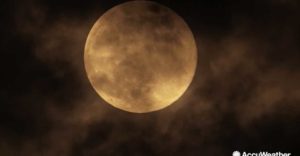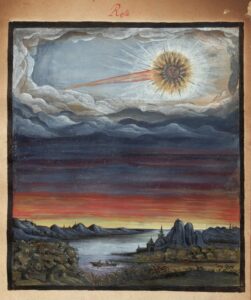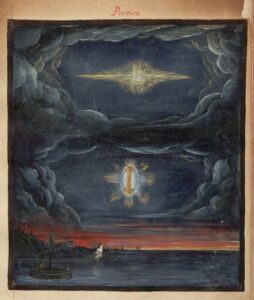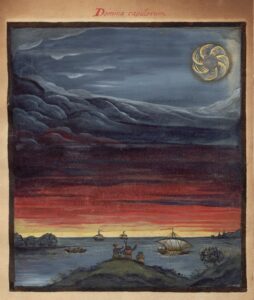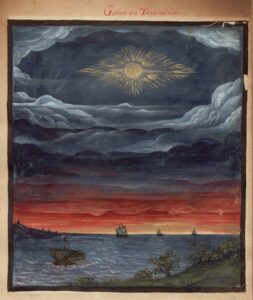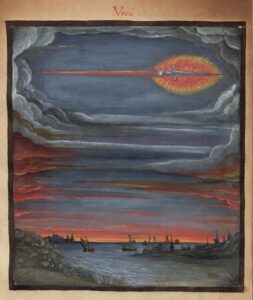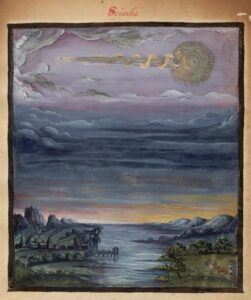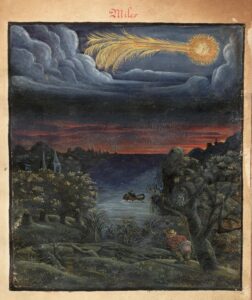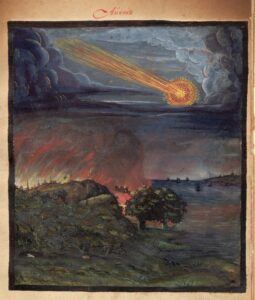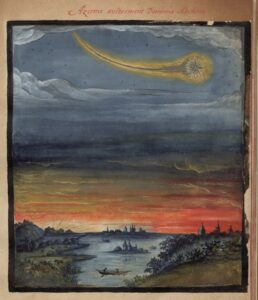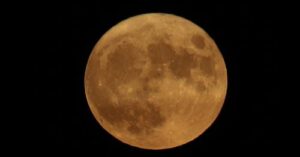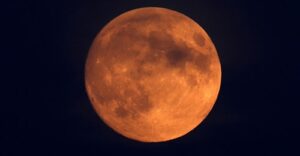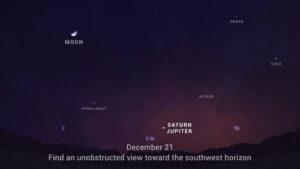Worm Moon Tonight!
From CNN:
One of the brightest heralds of spring makes its appearance this week.
(See more below for, er, how it got its name.)
The Comet Book (1587)
THE COMET BOOK (1587)
(Images and text from THE PUBLIC DOMAIN REVIEW.)
“This stunning set of images come from a 16th-century treatise on comets, created anonymously in Flanders (now northern France) and now held at the Universitätsbibliothek Kassel. Commonly known as The Comet Book (or Kometenbuch in German), its full title translates as “Comets and their General and Particular Meanings, According to Ptolomeé, Albumasar, Haly, Aliquind and other Astrologers.””
Comet Leonard 2021
There’ve been some remarkable photos of Comet Leonard as it approaches the sun. Here are a few recent ones, taken from Sky and Telescope.
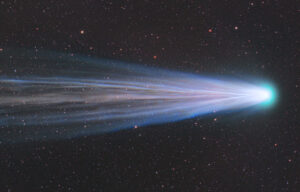
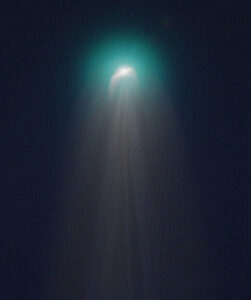
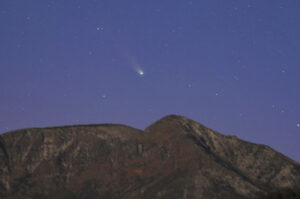
Beaver Moon Lunar Eclipse, Nov 18-19: the Longest Lunar Eclipse in 580 Years
Heads up for this spectacular lunar eclipse in the pre-dawn hours of Nov 19, 2021. Lasting 6 hours, it’ll be the longest lunar eclipse in almost 600 years. Expect excellent visibility all across North and South America, much of Asia, and parts of Europe and west Africa. During the period of maximum eclipse, the Moon may appear a deep red color.
In North America, the period of maximum eclipse will be right around 4:00 a.m. EST, with almost 2 hours of partial eclipse before and after that.
More below, from Space.com.
Beaver Moon lunar eclipse 2021: When, where and how to see it on Nov. 19
Visibility will be excellent across the Americas, much of Asia and parts of Europe and west Africa, and with the long event time you’ll have maximum opportunity to dodge clouds or crowded schedules to see the event unfold.
“Partial lunar eclipses might not be quite as spectacular as total lunar eclipses – where the moon is completely covered in Earth’s shadow – but they occur more frequently,” NASA said in a description of the eclipse. “And that just means more opportunities to witness little changes in our solar system that sometimes occur right before our eyes.”
Lunar eclipses are long events. This one will last about six hours and will peak at 4:02 a.m. EST (0902 GMT). The event will be visible from North and South America, Australia, and parts of Europe and Asia.
The moon will then arrive at the umbra, or the darker part of the shadow, at 2:18 a.m. EST (0718 GMT). Here you will get to enjoy about 3.5 hours of the moon passing through the deep shadow until it exits the umbra at 5:47 a.m. (1047 GMT). The eclipse will end at 6:03 a.m. EST (1203 GMT).
Assuming you can see the entire eclipse, the moon will have different appearances at different stages of the event. While it is in the penumbra or lighter part of the Earth’s shadow, it may be difficult for you to see anything at all, especially if you live in a light-polluted region. But as the moon moves closer to the umbra or deep shadow, it will begin to darken, turning a bit greyer than usual.
As the moon approaches the deepest part of the eclipse, the moon will likely turn a dark red or a brown region as it will be 97% eclipsed at the peak. The moon won’t be covered all the way, though, as at the point of greatest eclipse there will still be a region near the bottom of the moon (or top of the moon, if you are viewing through many kinds of telescopes) that is in full sunlight.
Depending on where you are located, you may not be able to see all of the eclipse. The entire sequence is visible for most of North and Central America, along with the far east of Asia, although extreme eastern regions of the Americas may only be able to view the eclipse before the moon exits the umbral phase.
South America will see most of the eclipse before moonset. Europe and western Africa will see some of the beginning of the eclipse, and central Asia along with the southern Pacific and Australia will see some of the eclipse around moonrise. You can find more details about your region at the NASA website.
Comet Leonard – the New Year’s Comet
Look for Comet Leonard–sighted just last year–to make a bright showing this New Year’s.

From EarthSky News:
Exciting news! A much-anticipated comet is brightening and still might become 2021’s brightest comet. Astronomer Greg Leonard discovered the comet that now bears his name – C/2021 A1 (Leonard) – last January 3. Astronomers reported then that discovery images showed a tail for the comet, suggesting we might see a nice tail as Comet Leonard draws closer to the Earth and sun. The comet is now between the orbits of Mars and Earth, heading inward. Comets are typically brightest around the time they’re closest to the sun. And Comet Leonard will reach perihelion, its closest point to the sun, around January 3, 2022. That’s after its closest point to Earth on December 12.
Read more here.
Hunter’s Moon Tonight, Oct. 20
You don’t have to be a hunter to enjoy the Hunter’s Moon tonight, Oct. 20. More below from EarthSky. Happy viewing and/or hunting.
“The Hunter’s Moon is the full moon after the Harvest Moon. It usually falls in October, but, if not, it falls in early November. [ . . .] It’s a characteristic of the Hunter’s Moon to rise around the time of sunset for several evenings in a row, as if this month has more than one full moon.”

Hunter’s Moon October 20, 2021
The Hunter’s Moon is the full moon after the Harvest Moon. It usually falls in October, but, if not, it falls in early November. October 2021’s full moon – the Northern Hemisphere’s Hunter’s Moon – will be 100% lit on October 20 at 14:56 UTC; translate UTC to your time. On October 21, and even on October 22, you might glimpse a full round moon ascending in the east in early evening. It’s a characteristic of the Hunter’s Moon to rise around the time of sunset for several evenings in a row, as if this month has more than one full moon.
Eastern Australia and New Zealand will see the full moon on October 21. It’s not a Hunter’s Moon for the Southern Hemisphere because it’s spring in that hemisphere now. So the full moon has different characteristics.
Every full moon has a slew of nicknames, and most are tied to months of the year. But some moon names, such as the Harvest and Hunter’s Moons, are tied to seasons. The Harvest Moon is the full moon closest to the September equinox, or autumnal equinox for the Northern Hemisphere. The equinox is typically September 22 or 23. So most Harvest Moons come in September. But, every three years, the Harvest Moon falls in early October and the Hunter’s Moon in November.
In North America, the Harvest Moon was a time when the bright moon meant farmers could stay out later, working in their fields, gathering in the crops before the first freeze. After the harvest, farmers would turn to hunting deer and other animals to bolster their food stores before winter. The light of the full moon would let them hunt into the evening hours. So today we have a Hunter’s Moon.
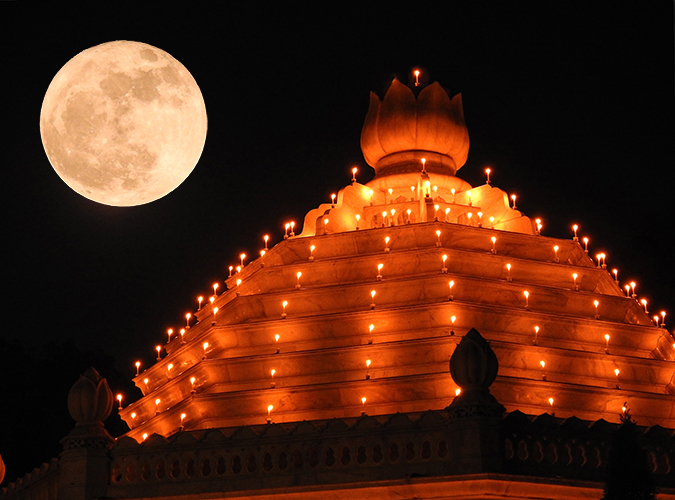
What makes this moon special?
Nature is particularly cooperative around the time of the autumn equinox to make the fall full moonrises unique. On average, the moon rises about 50 minutes later each day. But when a full moon happens close to the autumnal equinox – either a Harvest or a Hunter’s Moon – the moon (at mid-temperate latitudes) rises only about 30 to 35 minutes later daily for several days before and after the full moon. The reason is that the ecliptic – or the moon’s orbital path – makes a narrow angle with the evening horizon around the time of the autumn equinox.
The result is that there’s a shorter-than-usual lag time between successive moonrises around the full Hunter’s Moon.
Early evening moonrises make every Hunter’s Moon special. Every full moon rises around sunset. After the full Hunter’s Moon, you’ll see the moon ascending in the east relatively soon after sunset for a few days in a row at northerly latitudes.
If you’re in the Northern Hemisphere, look for the moon to be bright and full-looking for several nights from around October 19 to the 22. Around all of these nights, you’ll see a bright round moon ascending in the east in the evening hours.
Harvest Moon Tonight – Which I’m Calling the “Hurricane Moon”
It’s not too late to catch 2021’s Harvest Moon. From NPR: “For three days, moonrise will come shortly after sunset, but the harvest moon will reach its peak illumination at 7:54 p.m. ET Monday. Historically this lunar event provided farmers a little extra light to harvest their crops.”
Read more below. Happy viewing, and happy Fall.
For those in the Northern Hemisphere, summer will come to an end next Wednesday. Slowly but surely since the middle of June, days have been getting shorter. With the arrival of the autumn equinox comes cooler weather and a change of color amongst the trees. And Monday, two days before the official start of fall, the harvest moon.
For three days, moonrise will come shortly after sunset, but the harvest moon will reach its peak illumination at 7:54 p.m. ET Monday. Historically this lunar event provided farmers a little extra light to harvest their crops. However, unlike the equinoxes, which take place at the same time each year, the harvest moon is the full moon closest to the autumnal equinox. Which means it can fall in September or October, according to The Old Farmer’s Almanac.
But that’s not all that changes with the last full moon of the summer. You may recall glancing up at the night sky and noticed the moon varies in size from time to time. That’s because the its orbit around the Earth isn’t a perfect circle, NASA explains.
Sometimes the harvest moon appears to be enormous, such as in 2015, when it was the year’s closest and biggest super moon. The moon appears so much larger during super moon events because it’s closer to Earth, known as the perigee. At its closest point the moon is about 226,000 miles from Earth. But sometimes the harvest moon occurs when the moon is furthest from Earth in orbit, the apogee, at 253,000 miles away.
If spectators catch the moon rising at just the right time, it will appear orange in color. But this theatrical touch isn’t specific to the harvest moon. The moon varies in color depending on a handful of factors, including where the viewer is standing. When Earth’s satellite is closest to the horizon it takes on a red or yellow color, NASA says. But as it continues to rise it will gradually take on its traditional pale, white color.
East Asian culture celebrates the August Moon Festival, which doesn’t always coincide with the rising of the harvest moon itself. According to the Boston Public Library, the festival can be traced back to 771 B.C. and was celebrated by harvesting rice and wheat on the night of the full moon. Similar to Thanksgiving in the United States, the August moon is celebrated by the gathering of friends and families, but instead of turkey, people eat mooncakes, a sweet and savory dessert.
SUPER FLOWER BLOOD MOON Tomorrow, May 26
How to Watch this Week’s Spectacular “Super Flower Flood Moon” Lunar Eclipse
By Sophie Lewis
“When this happens, the only light that reaches the moon’s surface is from the edges of the Earth’s atmosphere,” the space agency explains. “The air molecules from Earth’s atmosphere scatter out most of the blue light. The remaining light reflects onto the moon’s surface with a red glow, making the moon appear red in the night sky.”
NASA says the result will be a “ring of light” around the moon.
“Just how red it will look is hard to predict, but dust in the atmosphere can have an effect. (And keep in mind there have been a couple of prominent volcanic eruptions recently),” NASA said.
Not only does May bring a lunar eclipse, but also the year’s best supermoon. A supermoon occurs when the moon appears larger than usual in the night sky because it is at its closest point to Earth in its orbit, known as perigee.
May’s full supermoon is known as the “Flower Moon,” and it marks the second of three supermoons this year. It’s appropriately named for the abundance of flowers associated with spring in the Northern Hemisphere.
How to watch
On Wednesday, May 26, the cosmic phenomenon will be at least partly visible anywhere on the night side of the planet, NASA said. Under clear weather conditions, skywatchers around the world will be able to enjoy the show.
This includes parts of Asia and Australia, as well as much of the U.S. and South America. For skywatchers in the U.S., the best viewing will be in Hawaii, Alaska, and the western states, though the eclipse is partially visible further East during dawn twilight. And if you’re in the U.S. you should wake up early to see the rare celestial event.
According to NASA, the peak of the eclipse will last for about 14 minutes, but the entire event will last about five hours, from 08:47:39 UTC (Coordinated Universal Time) to 13:49:41 UTC. It will peak at 11:19:52 UTC.
This means that in Asia, the eclipse occurs in the early evening when the moon first rises, while on the west coast of the Americas, it occurs in the early morning hours, when the moon is setting.
Solar eclipses should never be viewed with the naked eye, but lunar eclipses are completely safe to look at.
Don’t worry if you’re not located in the best place to spot the eclipse. The Virtual Telescope Project will have a live feed of the entire event, starting at 3 a.m. PT on May 26.
Rare Christmas Star Tonight
Heads up, star gazers. Tonight and tomorrow night you can catch a once-in-400-year celestial event: the conjunction of Jupiter and Saturn on the Winter Solstice to form a rare “Christmas Star.” This year it also coincides with the Ursid Meteor Shower. You’ll be able to see it all without a telescope, as long as your city’s not too bright. A big holiday show in the sky.
Happy holidays, and happy viewing. More info below.
Dec. 15, 2020
The ‘Great’ Conjunction of Jupiter and Saturn
Skywatchers are in for an end-of-year treat. What has become known popularly as the “Christmas Star” is an especially vibrant planetary conjunction easily visible in the evening sky over the next two weeks as the bright planets Jupiter and Saturn come together, culminating on the night of Dec. 21.
In 1610, Italian astronomer Galileo Galilei pointed his telescope to the night sky, discovering the four moons of Jupiter – Io, Europa, Ganymede, and Callisto. In that same year, Galileo also discovered a strange oval surrounding Saturn, which later observations determined to be its rings. These discoveries changed how people understood the far reaches of our solar system.
Thirteen years later, in 1623, the solar system’s two giant planets, Jupiter and Saturn, traveled together across the sky. Jupiter caught up to and passed Saturn, in an astronomical event known as a “Great Conjunction.”
“You can imagine the solar system to be a racetrack, with each of the planets as a runner in their own lane and the Earth toward the center of the stadium,” said Henry Throop, astronomer in the Planetary Science Division at NASA Headquarters in Washington. “From our vantage point, we’ll be able to be to see Jupiter on the inside lane, approaching Saturn all month and finally overtaking it on December 21.”
The planets regularly appear to pass each other in the solar system, with the positions of Jupiter and Saturn being aligned in the sky about once every 20 years.
What makes this year’s spectacle so rare, then? It’s been nearly 400 years since the planets passed this close to each other in the sky, and nearly 800 years since the alignment of Saturn and Jupiter occurred at night, as it will for 2020, allowing nearly everyone around the world to witness this “great conjunction.”
The closest alignment will appear just a tenth of a degree apart and last for a few days. On the 21st, they will appear so close that a pinkie finger at arm’s length will easily cover both planets in the sky. The planets will be easy to see with the unaided eye by looking toward the southwest just after sunset.
From our vantage point on Earth the huge gas giants will appear very close together, but they will remain hundreds of millions of miles apart in space. And while the conjunction is happening on the same day as the winter solstice, the timing is merely a coincidence, based on the orbits of the planets and the tilt of the Earth.
“Conjunctions like this could happen on any day of the year, depending on where the planets are in their orbits,” said Throop. “The date of the conjunction is determined by the positions of Jupiter, Saturn, and the Earth in their paths around the Sun, while the date of the solstice is determined by the tilt of Earth’s axis. The solstice is the longest night of the year, so this rare coincidence will give people a great chance to go outside and see the solar system.”
Want to learn when and where to look up? Join Throop as he talks about the “Great Conjunction” on #NASAScience Live Thursday, Dec. 17. Submit your questions by using #askNASA. The NASA Science Live episode will air live at 3 p.m. EST Thursday on NASA Television and the agency’s website, along with the NASA Facebook, YouTube, and Periscope channels.
For those who would like to see this phenomenon for themselves, here’s what to do:
- Find a spot with an unobstructed view of the sky, such as a field or park. Jupiter and Saturn are bright, so they can be seen even from most cities.
- An hour after sunset, look to the southwestern sky. Jupiter will look like a bright star and be easily visible. Saturn will be slightly fainter and will appear slightly above and to the left of Jupiter until December 21, when Jupiter will overtake it and they will reverse positions in the sky.
- The planets can be seen with the unaided eye, but if you have binoculars or a small telescope, you may be able to see Jupiter’s four large moons orbiting the giant planet.
Each night, the two planets will appear closer low in the southwest in the hour after sunset as illustrated in the above graphic.

